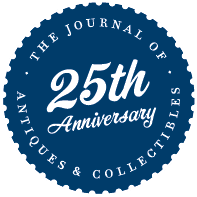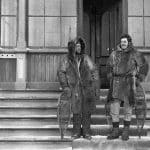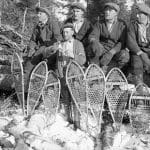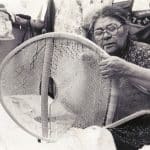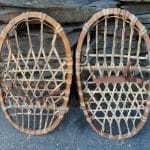Antiques Peek: November 2018
Walk This Way
by Jessica Kosinski
Snowshoeing is an activity not as widely practiced as it once was because modern conveniences like cars have replaced the need to trek across the snow on foot. The closest many of us now get to snowshoes is when we see them hanging on walls. They grace the walls of ski lodges, homes with rustic motifs and sports bars throughout the country. Strapping on snowshoes used to be a necessity here in the U.S. for many residents, and it is still a necessity in several parts of the world. Snowshoeing also has deep roots as a sport, especially in North America. So, let’s take a peek at the historic winter activity of snowshoeing, how it has evolved, and how to recognize and collect antique snowshoes today.
Native American Snowshoe Varieties
Although there is some debate over the origins of snowshoeing in the United States, one thing that is known is the practice of snowshoeing dates back to at least 4000 B.C. in Central Asia. It is believed that the land bridge that once existed in the Bering Straits allowed people traveling into North America to bring the practice of snowshoeing with them. Many Native American tribes have used snowshoes for winter travel for centuries.
Native American snowshoes can be fun to collect because they have unique tribal designs. In fact, most of them are named for the tribes that created them. For example, Huron snowshoes have unique paddle shapes. Ojibwa snowshoes, which have more pointed shapes, are also popular. The Athabascans relied heavily on their snowshoes for winter travel on the West Coast, and their snowshoes are recognizable by their toe designs – generally curved upward.
The Transference of Snowshoeing to Europeans in North America
The snowshoes made by woodland tribes tend to be most popular. Those designs were often copied by European traders and trappers, but did not truly become popular among British subjects in North America until 1758. Their increase in popularity stemmed from a specific battle that occurred during the French and Indian War. It occurred in Lake George, New York and was called the Battle on Snowshoes.
Snowshoes were also essential to scouting expeditions carried on across the young U.S.
The North American History of Snowshoeing as a Sport or Hobby
Snowshoes have long been used to get from point A to point B in the winter by multiple cultures. However, snowshoeing also has a long sporting history. Snowshoe hikes and races were organized in Canada in the 1700s, as were snowshoe clubs. Organized snowshoeing events remained popular in Canada from that point onward. The trend eventually extended down into the Eastern United States. There, snowshoeing was often done as a social activity in the winter, particularly in the early 1900s.
Modern Snowshoes
In the 1950s, the sport of snowshoeing was forever changed when the first metal snowshoe frames were produced. Wood snowshoes also underwent some changes that make them easy to date today. For example, prior to the 1950s, rawhide was used for the lacing of snowshoes. From the 1950s onward, some snowshoes incorporated man-made materials like nylon.
Post-1900 Snowshoe Producers
Snowshoe making was originally a practice done by individuals out of necessity. However, some companies and individuals eventually began producing snowshoes in larger quantities for resale. For example, the Chestnut Canoe Company founded in Canada in 1905 was known for their canoe production, but they also supplied snowshoes for members of the armed forces. Similarly, C.A. Lund was a producer of snowshoes for American armed forces during World War II. Floyd Westover was also a popular maker of snowshoes in the United States from the 1930s to the 1960s. In fact, he was responsible for creating a modern snowshoe design called the “Modified Bearpaw.”
Collecting Snowshoes Today
If you intend to actually use snowshoes in the winter today, purchasing a modern pair may be your best option. Modern snowshoes are built to be more durable and long-lasting than their traditional counterparts. However, as long as they are in good repair, antique snowshoes can still be used today.
Almost all antique snowshoes have some damage that occurs naturally with use or age. The wood frames easily crack, and the lacing also wears out or becomes snagged. Expect to spend several hundreds of dollars for antique snowshoes in good condition. Also, make sure to verify authenticity – snowshoes in excellent condition may be modern and made to look older. They may also be recently restored, and can make beautiful decorations and often retain a fair amount of monetary value.
You can opt to buy damaged antique snowshoes, which are often less expensive, and restore them yourself. There are many books and online resources you can use to learn snowshoe restoration practices. However, repairing snowshoes can take a lot of time, so it is best done if you want to take it up as a long-term hobby. If you are just looking for one pair to hang on your wall for decoration but do not want to spend the money required to get a pair in excellent condition, consider displaying a damaged pair. Snowshoes with minor damage often have a lot of character and provide a better sense of history when used as decorations.
Jessica Kosinski has been a freelance writer specializing in writing short articles for 15 years. She is also an avid collector of both antique books and Star Wars memorabilia. Although she is not in the antiques industry professionally, she has learned a lot about antiques over the years by periodically helping out at her mom’s antiques shop in Greenville, NH. She currently balances maintaining the antiques shop’s Facebook page, www.facebook.com/MallofNE, and working on various freelance writing assignments. She can be reached at dementorskiss77@yahoo.com.
